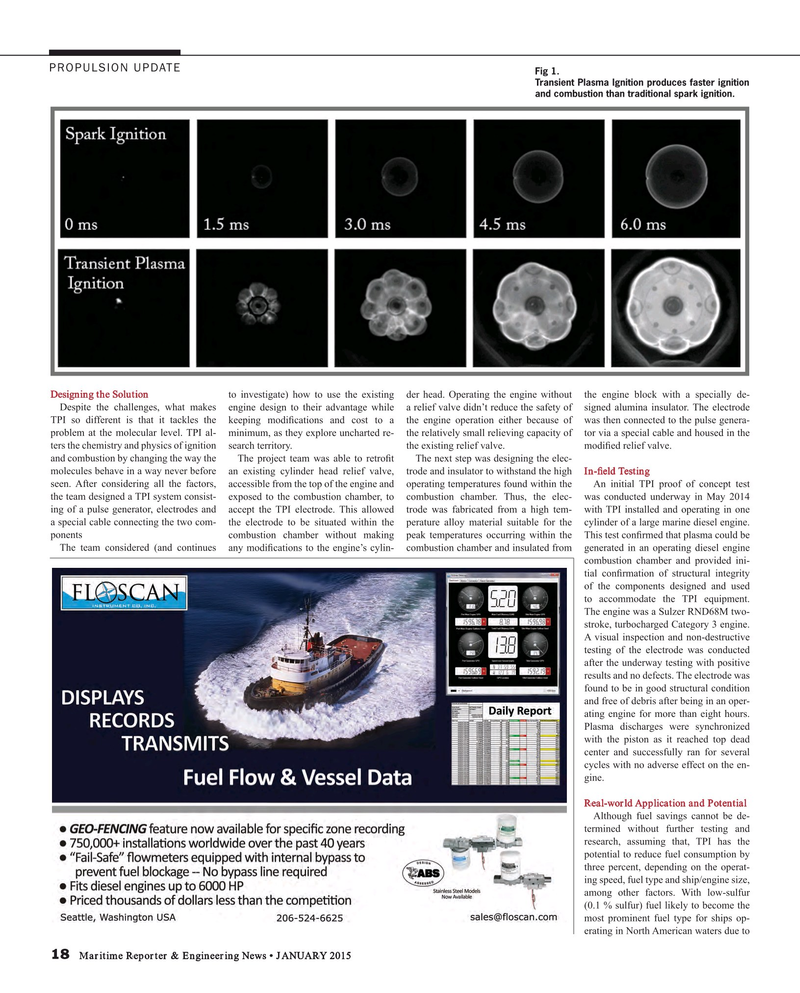
Page 18: of Maritime Reporter Magazine (January 2015)
Ship Repair & Conversion Edition
Read this page in Pdf, Flash or Html5 edition of January 2015 Maritime Reporter Magazine
PROPULSION UPDATE
Fig 1.
Transient Plasma Ignition produces faster ignition and combustion than traditional spark ignition.
Designing the Solution to investigate) how to use the existing der head. Operating the engine without the engine block with a specially de-
Despite the challenges, what makes engine design to their advantage while a relief valve didn’t reduce the safety of signed alumina insulator. The electrode
TPI so different is that it tackles the keeping modi? cations and cost to a the engine operation either because of was then connected to the pulse genera- problem at the molecular level. TPI al- minimum, as they explore uncharted re- the relatively small relieving capacity of tor via a special cable and housed in the ters the chemistry and physics of ignition search territory. the existing relief valve. modi? ed relief valve. and combustion by changing the way the The project team was able to retro? t The next step was designing the elec- molecules behave in a way never before an existing cylinder head relief valve, trode and insulator to withstand the high In-? eld Testing seen. After considering all the factors, accessible from the top of the engine and operating temperatures found within the An initial TPI proof of concept test the team designed a TPI system consist- exposed to the combustion chamber, to combustion chamber. Thus, the elec- was conducted underway in May 2014 ing of a pulse generator, electrodes and accept the TPI electrode. This allowed trode was fabricated from a high tem- with TPI installed and operating in one a special cable connecting the two com- the electrode to be situated within the perature alloy material suitable for the cylinder of a large marine diesel engine. ponents combustion chamber without making peak temperatures occurring within the This test con? rmed that plasma could be
The team considered (and continues any modi? cations to the engine’s cylin- combustion chamber and insulated from generated in an operating diesel engine combustion chamber and provided ini- tial con? rmation of structural integrity of the components designed and used to accommodate the TPI equipment.
The engine was a Sulzer RND68M two- stroke, turbocharged Category 3 engine.
A visual inspection and non-destructive testing of the electrode was conducted after the underway testing with positive results and no defects. The electrode was found to be in good structural condition and free of debris after being in an oper- ating engine for more than eight hours.
Plasma discharges were synchronized with the piston as it reached top dead center and successfully ran for several cycles with no adverse effect on the en- gine.
Real-world Application and Potential
Although fuel savings cannot be de- termined without further testing and research, assuming that, TPI has the potential to reduce fuel consumption by three percent, depending on the operat- ing speed, fuel type and ship/engine size, among other factors. With low-sulfur (0.1 % sulfur) fuel likely to become the most prominent fuel type for ships op- erating in North American waters due to 18 Maritime Reporter & Engineering News • JANUARY 2015
MR #1 (18-25).indd 18 MR #1 (18-25).indd 18 1/7/2015 9:50:55 AM1/7/2015 9:50:55 AM

 17
17

 19
19
